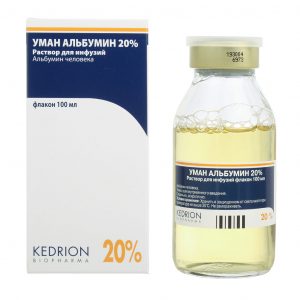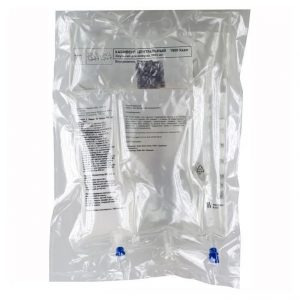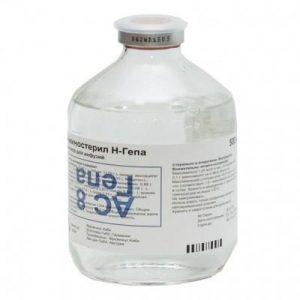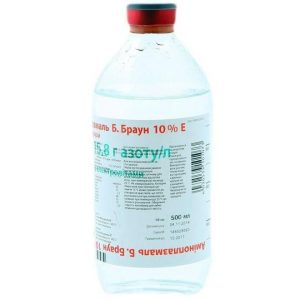Description
Latin name
Kabiven
Release form
Infusion emulsion formed after mixing the contents of the three chambers of a three-chamber bag, homogeneous, white.
Packaging
1026 ml each in a three-chamber plastic container (with two ports), 4 bags per pack.
Indications
Balanced parenteral nutrition in adults and children (including long-term).
Contraindications
known hypersensitivity to egg or soy proteins or any auxiliary component of the drug
severe hyperlipidemia
severe hepatic insufficiency
severe clotting disorders
severe congenital hemorrhage acute or severe administration of insulin in an amount of more than 6 units / h
pathologically increased plasma concentration the blood of any of the members of the electrolyte formulation
general contraindications to infusion therapy: acute pulmonary edema, hyperhydration, decompensated heart failure, hypotonic dehydration
unstable conditions (e.g. post-traumatic condition, uncompensated diabetes mellitus, acute myocardial infarction, decompensated metabolic acidosis, severe sepsis and hyperosmolar coma).
Caution: impaired lipid metabolism due to kidney failure, diabetes mellitus, pancreatitis, impaired liver function, hypothyroidism (with hypertriglyceridemia), or sepsis. With the introduction of the drug Kabiven ® to the central patient with such disorders, careful monitoring of the concentration of triglycerides in the blood plasma is necessary. Kabiven ® Central is intended primarily for patients older than 2 years. In children under 2 years of age, Kabiven ® Central can be used only for health reasons in the absence of special adapted amino acid solutions containing taurine (Aminoven infant). Premature infants and low birth weight babies may have impaired fat metabolism. Carefully monitor triglyceride levels.
Special instructions
Central cabivan has an osmolarity of 1060 mOsm / l and therefore is not suitable for iv administration into peripheral veins in both adults and children because of the risk of thrombophlebitis. With the introduction of Kabiven to central patients with impaired lipid metabolism due to renal failure, diabetes mellitus, pancreatitis, impaired liver function, hypothyroidism (with hypertriglyceridemia) or sepsis, careful monitoring of the concentration of TG in the blood plasma is necessary. When using the drug, it is necessary to control the ability to remove lipids by measuring the concentration of TG in blood plasma 5-6 hours after the last intake of fats. Fat overload syndrome can be observed at the recommended infusion rate if the patient’s clinical condition changes dramatically and severe renal or hepatic failure develops. The volume of the administered drug should be carefully calculated and adjusted in accordance with the water balance and nutritional status of the patient. Each container is intended for single use. Severe disturbances in electrolyte and water balance must be corrected before the start of infusion.
Patient monitoring is required at the start of infusion. Since any infusion into the central vein is associated with an increased risk of infection, during catheter insertion or during manipulation with it, strict aseptic rules should be followed to avoid infection. It is necessary to regularly check the concentration of glucose and electrolytes in blood plasma, as well as osmolarity, water balance, acid-base state and activity of liver enzymes. With prolonged administration of lipids, the cellular composition of the blood and blood coagulation parameters should be monitored.
There are no vitamins and minerals in this preparation, therefore, to conduct complete parenteral nutrition, they should be added additionally. To replenish them, it is recommended to use Vitalipid N Adult or Vitalipid N Children, Soluvit N, Addamel N. If any symptoms and signs of allergic reactions appear, the infusion should be stopped immediately.
The presence of lipids in Kabiven central can alter the results of some laboratory tests (for example, bilirubin concentration, lactate dehydrogenase activity, hemoglobin oxygen saturation) if a blood sample was obtained before lipids were sufficiently removed from the bloodstream. In most patients, the injected lipids are excreted after 5-6 hours. In / in the introduction of amino acids may be accompanied by increased renal excretion of trace elements, especially zinc. Patients who need long-term IV nutrition may need additional micronutrient administration.
In severely malnourished patients, the onset of parenteral nutrition can cause a shift in water balance, leading to pulmonary edema and congestive heart failure. In addition, within 24-48 hours in the blood plasma, a decrease in the concentrations of potassium, phosphorus, magnesium and water soluble vitamins. It is recommended to start parenteral nutrition slowly with careful monitoring and appropriate correction of the amount of fluid, electrolytes, vitamins and trace elements.
Kabiven Central should not be administered through a single catheter and simultaneously with blood or blood products because of the risk of developing pseudoagglutination. Patients with hyperglycemia may require administration of insulin. A venous catheter through which complete parenteral nutrition is administered is not recommended for intravenous administration of other solutions and preparations. Any residues from an open container must be destroyed.
After releasing the fixatives and mixing the three solutions, compatible additives can be added to the mixture through the inlet. After the latches are opened, the chemical and physical stability of the mixed contents of the three chambers is maintained for 24 hours at 25 ° C. To ensure microbiological safety, the mixture should be used immediately after the introduction of additives. If the mixture is not used immediately, provided that aseptic is observed, when the additives are added, the emulsion mixture can be stored for up to 6 days at a temperature of 2 ° to 8 ° C, after which the mixture should be used for 24 hours.
primarily for patients older than 2 years. In children under the age of 2 years, Kabiven Central can be used only for health reasons in the absence of special adapted amino acid solutions containing taurine (Aminoven infant). Premature infants and low birth weight babies may have impaired fat metabolism. The concentration of TG should be carefully monitored.
Composition
Active substances: Dextrose solution 19% 526 ml Vamin 18 Novum solution 300 ml Intralipid 20% 200 ml.
Excipients: water for and.
Dosing and Administration
Before use, divide the septum and mix the contents of the three chambers. The drug is administered intravenously, only in the central veins.
For most patients (ICU, surgery, oncology), the need for energy is 25-35 kcal / kg, in amino acids 1-1.6 g / kg = 25-35 ml of central Cabiven per 1 kg per day.
With an energy requirement of 20-25 in amino acids is about 1 g / kg / day = 20-25 ml of central Cabiven per 1 kg of body weight per day.
Maximum daily dose
Adults – 40 ml / kg body weight per day.
Children: Dosage is determined by the patient’s ability to metabolize certain nutrients.
Infusion in children (2 to 10 years old) should be started with low doses (14-28 ml / kg / day, the dose should be increased by 10-15 ml / kg / day, up to a maximum of 40 ml / kg / day).
In children over 10 years of age, the same doses as in adults can be used.
Storage conditions
Store at a temperature not exceeding 25 ° C. Do not freeze. The chemical and physical stability of the mixed contents of the three chambers is maintained for 24 hours at 25 ° C. To ensure microbiological safety, the mixture should be used immediately after the introduction of additives. If the mixture is not used immediately, if the aseptic is followed, when the additives are added, the emulsion mixture can be stored for up to 6 days at a temperature of 2 ° to 8 ° C, after which the mixture should be used for 24 hours.
Expiration
2 years.
Deystvuyuschee substances
amino acids for parenteral POWER
dosage form
emulsion for infusion
fresenius cabi, Germany




